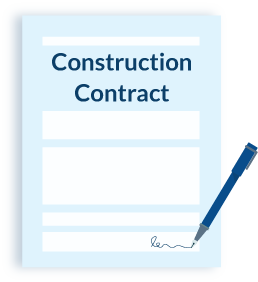
When a general contractor strikes out on their own, they have the opportunity to design their business how they want to. They can take the projects that they want, hire who they want, and create payment terms that work for them. But, if you’re a homeowner or subcontractor, even the most common contractor payment terms might make you a little uncomfortable.
At first glance, it can seem like a GC is trying to take advantage of their customers or subs with how they structure their payment terms. Let’s take a look at what the most common payment terms for contractors are, so you can make an informed decision on who you want to work with.
Who sets contractor payment terms?
The payment terms of a contract are the result of an agreement between a contractor and subcontractor. They two set the terms when they negotiate the contract. Any part of the contract is up for negotiation — pay schedules, price, discounts — so, ideally, the parties will reach terms that work for both sides.
Read more: Contractor Payment Schedules: What’s the Best for My Project?
On a construction project, an owner will hire a general contractor to oversee the entire project. The general contractor could be one person or a large firm specializing in general contracting. The general contractor will then hire out aspects of the project to subcontractors. Subs often hire their own subs, and so on, until the project wraps up.
Then, owners, GCs, and subs negotiate independent contracts at each level. The owner negotiates with the general contractor. The general contractor negotiates with their subs. The subs negotiate with their subs. It’s one long chain of payment term negotiation.
Deposits and down payments
On some residential projects, general contractors will negotiate, or require, a down payment or upfront deposit from the homeowner. This upfront payment serves to cover the costs of materials and initial labor. This is a common, everyday occurrence, and it’s entirely legal.
Property owners typically want to avoid paying a deposit, preferring to rely on the contractor to float the upfront costs. But, that might not be an option with some contractors — some set a deposit amount or percentage as part of their policy. Others might be a little more flexible and option to discuss other options.
Required deposit amounts can be anywhere from 10 percent on large, multi-stage projects to upward of 50 percent for smaller jobs. Somewhere between 25 to 33 percent is a reasonable expectation on medium projects. Anything more than 50 percent is unreasonable, project type notwithstanding.
Aside from very rare occasions, subcontractors don’t typically receive deposits from general contractors. Subs have to use their own capital to float their part of the project, including manpower and materials, and often don’t make a profit until the project wraps up completely.
How general contractors protect their cash flow
Higher tier contractors will often try to hedge their bets and protect their cash flow by using pay-when-paid clauses in their contracts. These clauses state that the subs on the project will only receive their payments once the owner pays the general contractor. This way, the general contractor isn’t out a bunch of cash before he receives payment from the owner.
Pay-when-paid clauses are legal, though they’re not always enforceable. Because these clauses are legal, states can use them to create laws stating how long the general contractor and subs have to pay their subs after receiving payment.
General contractors will also hold back a bit of the subcontractors’ payments until the end of the project to ensure they complete their tasks. This amount, commonly known as retainage, usually amounts to around 10% of each payment. While this is a legal and common practice in the industry, it also helps to shore up the GC’s cash flow.
Read more about how retainage works in The Ultimate Guide to Retainage in the Construction Industry.
Common payment terms in construction
So, what can homeowners or subcontractors expect when it comes time to cut the checks? How long does the homeowner have to pay an invoice? What’s a reasonable timeframe for a subcontractor to expect to wait for their payment?
According to Levelset’s 2020 Construction Survey, contractors are far more lenient on payment terms than they should be. Almost half of all construction businesses offer their customers 30 days or more to pay their invoices. On top of that, 8 percent offer terms in excess of 45 days.
Imagine if your credit card company was that laid back about their bills. Even if they were, you’d expect to pay a late fee once you overran your due date, right?
Only 11 percent of construction companies regularly charge interest or fees for late payments. An additional 21 percent sometimes charge for late payments.
The problem is: There’s really no incentive for a customer to pay early.
How lenient terms affect subcontractors
Three-quarters of all construction companies offer absolutely no early payment discounts. Imagine the amount of interest a company could save if all of their customers paid early. Talk about a win-win.
As a homeowner, a laid back payment schedule might seem like a blessing — but someone has to pay the price (literally). Pay-when-paid clauses — coupled with a lenient payment policy — mean that subcontractors could be out cash on work they finished for months at a time.
You might think that this issue isn’t your problem, but it could be in the future — read on to find out how.
Common construction payment terms by project size
The easiest way to break down the most common payment schemes is through project size. Some terms apply to smaller residential projects, while large commercial jobs have their own sets of common terms.
Common payment terms on small projects
When it comes to smaller projects, it’s common for a contractor to request higher upfront percentages than they might on larger projects. This upfront percentage will often cover all of the materials and a bit of the labor. Expect to pay 10–50 percent upfront to get the project off the ground.
After the initial deposit, the next payment usually comes at the end of the project.
Let’s use a small deck project as an example: The contractor and homeowner come to an agreed-upon price of $5,000. The homeowner can expect to pay the contractor $2,500 at the start of the project. So then, the remaining $2,500 is due when the contractor completes the deck.
Once the project wraps up, the contractor submits a bill for $2,500. For smaller jobs, homeowners are generally expected to pay the invoice upon receipt or shortly thereafter.
Common payment terms on medium projects
Contractors often structure the payment terms for medium-sized projects similarly to smaller jobs — with a few small tweaks.
Contractors complete medium-sized projects — such as those that last a few months — in stages. For that reason, deposits are usually smaller, and they schedule payment dates along the way. The initial deposit gets the project off the ground, while the scheduled payments keep it moving along.
As an example, let’s look at a $50,000 kitchen remodeling project that will take three months to complete. In this case, the contractor may require 20 percent upfront, 30 percent after month one, 30 percent after month two, and the remaining 20 percent when the project wraps up.
At each payment stage, the contractor should submit an invoice with the amount due and the date by which to pay it. As we know from earlier, it’s not uncommon for contractors to give property owners more than 30 days to make the payment.
Common payment terms on large projects
Large residential projects like homebuilding often require even lower percentages for deposits. In these scenarios, the general contractor might require a 10 percent down payment and then set up draws or progress payments throughout the rest of the project. The GC will then pay their subcontractors from these draws.
But this scheme doesn’t translate to commercial projects. General contractors rarely receive deposits on commercial contracts. Instead, they’ll have to float the job using their cash or credit accounts. At the same time, their subcontractors will have to float their portion of the project, and so on down the line.
On these projects, progress payments are the norm. They correlate with the project’s progress or schedule of values. Subcontractors will have to submit payment applications each month. If the general contractor negotiated pay-when-paid clauses into their subs’ contracts, those subcontractors have to wait as well.
If you thought the 30-day timeframe for residential payments was long, commercial projects can take months. It can take an average of 83 days for subs to get paid on these invoices.
Retainage is also a factor in commercial projects. Not only do most subs wait until the general contractor gets paid, but they also have to wait until the very end of the project (long after their portion is complete) to recover the rest of their cash. That bit of retainage often represents far more than their profit margin, which means they’re in the hole until the final checks make their way down the chain.

Free contract template download
Download a free construction contract template that works on almost any project.
Mechanics liens: What happens when payment terms aren’t met
Obviously, there’s a common theme here: It can take a long time to get paid, even on small projects. States provide a tool that contractors and subcontractors can use to speed up the payment train: the mechanics lien.
If project owners or general contractors aren’t adhering to payment deadlines, the other contractors in the payment chain have the right to file a mechanics lien against the property. A mechanics lien can hinder the owner’s chances at securing further financing, make the property harder to sell, or cause the property to go up for auction in the event of a successful foreclosure suit.
And here’s the thing: Even if property owners are paying the general contractor on time, if the subs aren’t getting paid, they can file a lien. Do you remember earlier when I said that an unpaid subcontractor can become your business? This is what I was referring to.
Project owners need to ensure that their general contractor is following through with the payment terms that they agreed to in order to avoid issues with subcontractors filing liens.
